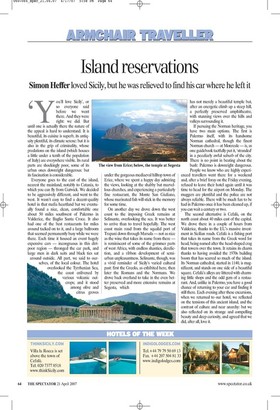Island reservations
Simon Heffer loved Sicily, but he was relieved to find his car where he left it ‘You’ll love Sicily’, or so everyone said before we went there. And they were right: we did. But until one is actually there the nature of the appeal is hard to understand. It is beautiful, its cuisine is superb, its antiquity plentiful, its climate serene: but it is also in the grip of criminality, whose predations on the island (which houses a little under a tenth of the population of Italy) are everywhere visible. Its rural parts are shockingly poor, some of its urban ones downright dangerous: but its fascination is considerable.
Everyone goes to the east of the island, nearest the mainland, notably to Catania, to which you can fly from Gatwick. We decided to be aggressively different, and went to the west. It wasn’t easy to find a decent-quality hotel in that mafia heartland but we eventually found a nice, clean, comfortable one about 50 miles southwest of Palermo in Valderice, the Baglio Santa Croce. It also had one of the best restaurants for miles around tacked on to it, and a large ballroom that seemed permanently busy while we were there. Each time it housed an event hugely expensive cars — incongruous in this dirtpoor region — thronged the car park, and large men in dark suits and black ties sat around outside. All part, we said to ourselves, of the local colour. The hotel overlooked the Tyrrhenian Sea, the coast enlivened by various volcanic outcrops; and it stood among olive and citrus groves under the gorgeous mediaeval hilltop town of Erice, where we spent a happy day admiring the views, looking at the shabby but marvellous churches, and experiencing a particularly fine restaurant, the Monte San Giuliano, whose marinated fish will stick in the memory for some time.
On another day we drove down the west coast to the imposing Greek remains at Selinunte, overlooking the sea. It was better to arrive than to travel hopefully. The west coast main road from the squalid port of Trapani down through Marsala — not as nice as the wine that takes its name from there is reminiscent of some of the grimmer parts of west Africa, with endless shanties, dereliction, and a ribbon development of semiurban unpleasantness. Selinunte, though, was a vivid reminder of Sicily’s varied cultural past: first the Greeks, as exhibited here, then later the Romans and the Normans. We drove back overland to take in the even better preserved and more extensive remains at Segesta, which has not merely a beautiful temple but, after an energetic climb up a steep hill, a perfectly preserved amphitheatre, with stunning views over the hills and valleys surrounding it.
If pursuing the Norman heritage, you have two main options. The first is Palermo itself, with its handsome Norman cathedral, though the finest Norman church — at Monreale — is, as one guidebook tactfully put it, ‘stranded’ in a peculiarly awful suburb of the city. There is no point in beating about the bush: Palermo is downright dangerous. People we know who are highly experienced travellers went there for a weekend and, after a brief foray on the Friday evening, refused to leave their hotel again until it was time to head for the airport on Monday. The muggers are plentiful and the police are not always reliable. There will be much fun to be had in Palermo once it has been cleaned up, if you can wait a century or two.
The second alternative is Cefalù, on the north coast about 40 miles east of the capital. We drove there in a couple of hours from Valderice, thanks to the EU’s massive investment in Sicilian roads. Cefalù is a fishing port that takes its name from the Greek word for head, being named after the head-shaped crag that towers over the town. It retains its charm thanks to having avoided the 1970s building boom that has scarred so much of the island. Its Norman cathedral, started in 1140, is magnificent, and stands on one side of a beautiful square. Cefalù’s alleys are littered with charming little shops and the odd gem of a restaurant. And, unlike in Palermo, you have a good chance of returning to your car and finding it still there. Each evening after these excursions, when we returned to our hotel, we reflected on the tensions of this ancient island, and the contrast of culture and near anarchy: but we also reflected on its strange and compelling beauty and deep curiosity, and agreed that we did, after all, love it.


















































































 Previous page
Previous page